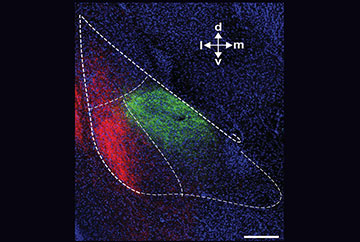
A fluorescent image of the basolateral amygdala (BLA; outlined) distinguishes between cells in the insular cortex (red) and the prefrontal cortex (green). [Image: Ipsit Srivastava/Weill Cornell Medicine]
Researchers in the United States and Germany have reportedly exploited a combination of optical techniques to identify a specific circuit in the brain that could be targeted by drugs to reduce anxiety and related conditions (Neuron, doi: 10.1016/j.neuron.2025.01.002). As well as improving treatments, the demonstration introduces a general strategy for using optical methods to map the effects of drugs within the brain, according to the researchers.
An optical toolkit
The pre-clinical study focused on a type of brain-cell receptor called metabotropic glutamate receptor 2 (mGluR2) that when activated inhibits the response from its host neuron. Previous studies have suggested that anxiety can be alleviated by activating mGluR2 within the part of the brain that generates fear and emotions, which is known as the basolateral amygdala (BLA). However, similar receptors are found throughout the brain, so drugs designed to activate mGluR2 could also cause unwanted side effects by impairing other neural functions.
The optical toolkit developed by the team is designed to help develop more targeted treatments by revealing the action of drugs within a specific circuit of interconnected neurons. One established technique is optogenetics, which can be used to make particular cells within the brains of living mice sensitive to light. In this study, the researchers employed this approach to generate fluorescence from both the general population of BLA cells and those that are rich in mGluR2, which allowed them to isolate two brain circuits that terminate in the BLA and that also contain high levels of the receptor.
Controlling mGluR2
Once activated, the receptors could be switched off using light at a slightly longer wavelength, providing rapid and reversible control of mGluR2 within the two circuits.
To investigate the effects of drugs on these circuits, the researchers tethered small light-sensitive molecules to the receptors, enabling mGluR2 within the mice to be activated when illuminated with light at 385 nm. Once activated, the receptors could be switched off using light at a slightly longer wavelength, providing rapid and reversible control of mGluR2 within the two circuits.
Activating the mGluR2 receptor in one of the BLA circuits was found to reduce spatial avoidance, a classic sign of anxiety in mice, but it also degraded their working memory. In the other circuit, which runs to the BLA from a sensory part of the brain called the insula, activating mGluR2 produced normal social and feeding behavior in the mice. This time there were no apparent cognitive impairments, suggesting that this circuit offers a viable therapeutic target for treating anxiety and related conditions.
A crucial next step for the team will be to find a way to target this circuit more selectively, using a receptor that is less abundant in the brain than mGluR2. The researchers also plan to use their optical toolkit to investigate the effects of other types of drugs, such as opioids and antidepressants, on specific circuits within the brain.
